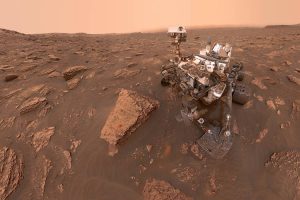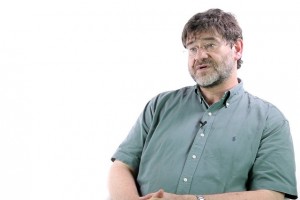Curiosity Rover
Mars Science Laboratory Project Scientist Ashwin Vasavada on finding signs of a habitable environement, the Ra...
The video is a part of the project British Scientists produced in collaboration between Serious Science and the British Council.
Today there are practically two ways to detect planets easily. Well, there are two main ways that have been used to detect planets that we know. The first one that started 20 years ago is using a technology which is called spectroscopy. So, what we do here is we look at the star and we build the spectra. The spectra is like a signature of the star. There are a lot of atoms in the atmosphere of the stars, and there are a lot of features in these spectra, it’s like a rainbow. And what we try to detect here is a motion of the star. Because if there is a planet orbiting that star, the star will move. And we can use that spectra to detect that motion. So what’s behind that is what’s called ‘the Doppler effect’ that connects a change of color with a change of speed. When you change the speed of the star, you change the color of the star a bit. So, we move the spectra a bit.
It’s something known for a long time, I mean, the spectroscopy is the old stuff: it’s about hundred years old, and the Doppler effect is even older. So, why have we waited so long to detect a planet then? Well, it’s because the motion that you have to detect is extremely small. It so small that you practically can’t measure it. It’s a bit like: you are blind and you try to see better than the actual picture you get, because you are blind. It requires a lot of strategy, because any tiny change (if you change the temperature, if you change the pressure) will make a motion of your spectra bigger than you try to detect. So, what happened recently is: we had a couple of technologies that we could benefit from. Well, the first one is computers. With computers come the detectors. We’re using electronic detectors, and these electronic detectors used to be very small at the beginning, and became bigger and bigger. You need a big detector to do spectroscopy, because there is a lot of spectra you want to record on it. You need to have a big detector.
On top of that, there’s a lot of new mathematics that has been used to just compute the speed because of the tiny motion you need to do. And there is lot of tricks also to record any change in the spectrograph. So, all these ingredients were new stuff that was invented a bit more than 20 years ago. That’s what we did, that’s what I did 20 years ago – setting up a new machine based on these ingredients on the telescope in the South of France. The machine is called ELODIE, and that was this spectrograph, with which we detected the first exoplanet on other stars. Since then we have made a lot of progress. We’re still using the same kind of technology, but we are way improved in what we can do. Now we can measure tiny-tiny changes. We measure better than a working man. So, there is something very tiny very far away. This is really a kind of an achievement of technology.
Within 20 years we have made tremendous progress in this technology. At the beginning we were barely able to detect a planet like Jupiter, and right now we’re detecting planets as small as the Earth, with a mass of the Earth. It still needs to be close to the star, so we are still limited to detect that kind of close-by compact Earth system. We don’t see or detect an Earth at the distance of the Earth, but we’re working on that. And that’s something that would soon be possible. The main parameter you extract from this technique is the period of the planet, the distance between the planet and the star, and then – the mass. Actually, we did get a minimum mass, but very close to the mass of the planet.
So, what is interesting is to combine this with a completely different technique, which is called ‘the transit’. In this case the planet goes in front of the star and you can use this event to compute the size of the planet. Practically, you do, you get the ratio between the size of the stars and the side of the planet. It’s a shadow practically going in front of the star. This is quite interesting, because it’s different on the mass. If you can get the mass of one of this transiting system as well, then the mass of the size gives you the density. And the density for physicists is magic, because it tells you what the ingredients are. If I found density like water, I will know that this kind of planet has a density of the water. It cannot be like the Earth. To be like the Earth, it has to be more dense. It has to be dense like silicate or rocks. That’s an interesting part of the game: trying to combine different techniques together. So, the transit has been a quite dramatic technique to detect a planet, because it has been used in space.
The first transit mission was the COROT mission. It has been used to find the first planet of the rocky type, of which we are sure. Why? Because we got the size and we got the mass, and combining the two we got the density. But then a much bigger and later systematic mission called Kepler from NASA made a quantum step, and we were able to detect a lot more planets than the COROT. It has provided us with a raw picture of the diversity of the planets. So, Kepler has found, I think, 4,000 planets. They found the size (we know the size of these planets). And what Kepler has taught us is: there are much more planets of the size of the Earth than of the size of Jupiter. We just count how many there are. We know also from Kepler that if there is a planet, there is a high chance there may be another one, and a third one, and the fourth one – they will come in systems.
So, the transit missions have been completely a game changer here, because by adding the size to the known planet, for which we can get the mass, by providing a systematic survey, by providing access to the multiplanetary systems, we have started to realize that there are plenty of different kinds of planets that are different from the solar systems. Transit, being sensitive to the planet very close, they have found a lot of planets much-much closer, than the one we have in the solar systems. By design, that’s the technique sensitive width.
We have realized that actually practically 50% of the stars have a planet of the size of the Earth, but extremely close. These planets have typically an orbit of 2 days, 5 days, 10 days, 15 days, 20 days, something much closer than Mercury. But it was quite a dramatic change in the perceptions of the diversity of the planets in the universe, because 20 years ago if you asked anyone, you would have been told: “Well, all planets should look like the solar system”. There were even some people that had predicted that nobody will detect any planet with the transit or with the Doppler spectroscopy, because these techniques are very adequate, very sensitive to a planet very close. When you go to a planet like the Earth or Jupiter, they are very far, and it is much more difficult to find them, because the amplitude of the signal, the motion of the star, the impact of the shadow is much more difficult to get.
In the future this will change, because what we all would like to get is a picture. We do have a couple of pictures of planets. We do have a couple only, because it’s difficult, because the light is just shining so bright. So, when you want to make a picture of a planet, you have to suppress the light from the stars, and you also have to deal with a more severe problem, which is the blur of the atmosphere. We have something between us, the telescopes and the sky, which is the atmosphere. The atmosphere is moving a bit. So there are tricks being used with active optics to correct all these effects and to try to freeze the picture, making it very good. And these are the ways that have been used to make the very first picture of the system. We have a new series of telescopes being built right now, which have much a bigger mirror. With this mirror and the very same technique used to make pictures we hope that we will make a lot of progress. And maybe the next big discoveries of future exoplanets will not come from velocity or transit, but will come from these direct imaging techniques, providing us with a picture of this world, and hopefully with details about the atmosphere of these planets on other stars.

Mars Science Laboratory Project Scientist Ashwin Vasavada on finding signs of a habitable environement, the Ra...

Staff Member at Max Planck Institute for Solar System Research, Paul Hartogh, on the use of the deuterium/hydr...

Princeton University Prof. Lyman Page on development of the hot Big Bang theory, dipole term of CMB, and probi...